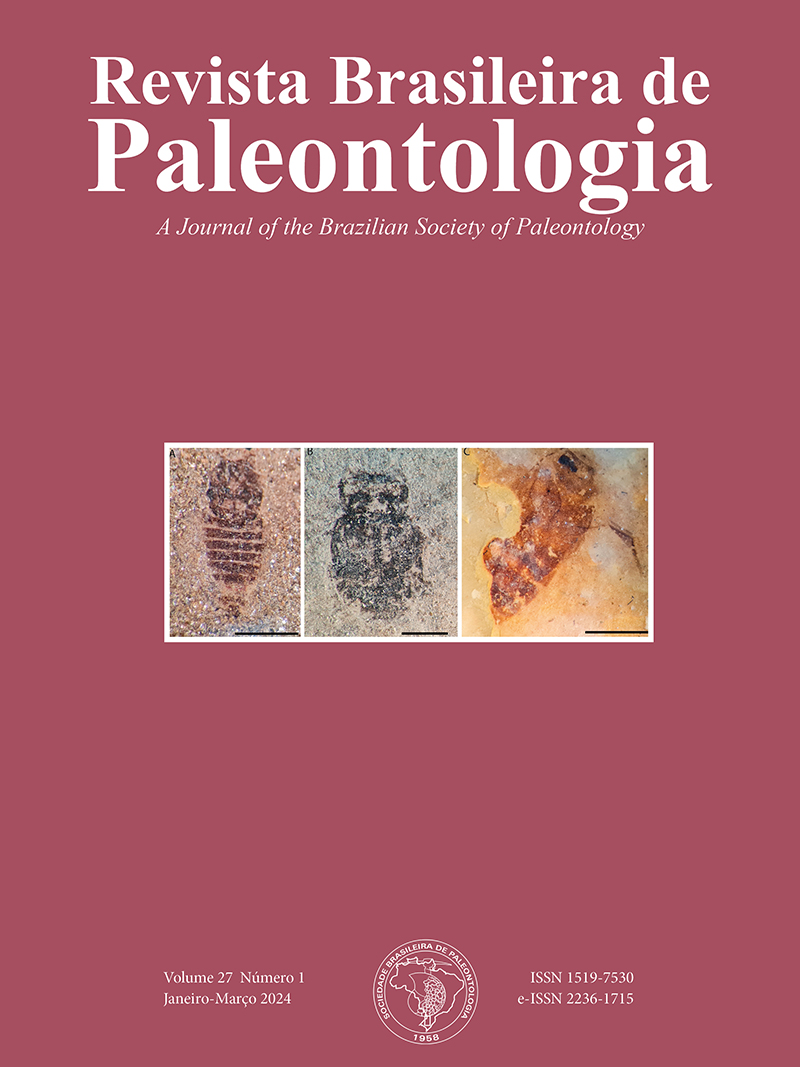Novos espinhos de nadadeiras de Chondrichthyes fósseis da Bacia do Parnaíba, Formação Pedra de Fogo (Permiano) no Estado do Tocantins, Brasil
DOI:
https://doi.org/10.4072/rbp.2024.1.0408Resumen
New Chondrichthyes fin spines fossils from the Pedra de Fogo Formation (Permian) in State of Tocantins, Brazil. The Parnaíba Basin has a unique fossil record of Chondrichthyes that lived during the Permian period. Within this basin is the Pedra de Fogo Formation, dating from the Cisuralian, which is distributed in parts of the states of Pará, Tocantins, Piauí, Maranhão, Ceará, and Bahia. Due to their cartilaginous skeleton, Chondrichthyes skeletal remains are not prone to fossilization, with teeth, fin spines and dermal denticles being more commonly found. The main objective of this work is to describe new fins spines from the Parnaíba Basin, collected in the State of Tocantins and stored at the Museum of Archeology and Paleontology of the Federal University of Piauí. Six shark spines were identified as belonging to Ctenacanthiformes. A more specific classification at the genus and species level is still uncertain due to the difficulties with the definition of such taxa and incompleteness of the described remains. These occurrences contribute to future research in the area concerning about on fossil fin spines found in the Parnaíba Basin.
Keywords: Ctenacanthus, Ctenacanthiformes, paleohistology, Paleozoic.
Resumo – A Bacia sedimentar do Parnaíba possui registros fossilíferos únicos de Chondrichthyes que viveram no Período Permiano. Nela se encontra a Formação Pedra de Fogo datada como Cisuraliano e distribuída em parte dos estados do Pará, Tocantins, Piauí, Maranhão, Ceará e Bahia. Devido ao seu esqueleto de natureza cartilaginosa, os condrictes não são propensos à fossilização, sendo mais comumente encontrados dentes, espinhos de nadadeiras e dentículos dermais. O presente trabalho tem como principal objetivo descrever novos espinhos de tubarões fósseis da Bacia do Parnaíba, coletados no Estado do Tocantins e armazenados no Museu de Arqueologia e Paleontologia da Universidade Federal do Piauí. Um total de seis espinhos de tubarão fóssil foram identificados como pertencentes aos Ctenacanthiformes. Uma classificação mais específica em nível de gênero e espécie ainda é incerta, por problemáticas na definição de tais táxons e ausência de partes mais completas. Esta ocorrência contribui para futuros trabalhos na área acerca dos fósseis de espinhos de nadadeiras de tubarões encontrados na Bacia do Parnaíba.
Palavras-chave: Ctenacanthus, Ctenacanthiformes, paleohistologia, Paleozoico.
Descargas
Descargas
Publicado
Cómo citar
Número
Sección
Licencia
Derechos de autor 2024 Revista Brasileira de Paleontologia

Esta obra está bajo una licencia internacional Creative Commons Atribución 4.0.
This is an Open Access article distributed under the terms of the Creative Commons Attribution-NonCommercial-NoDerivatives license (http://creativecommons.org/licenses/by-nc-nd/4.0), which permits non-commercial re-use, distribution, and reproduction in any medium, provided that no alterations are made and the original article is properly cited. The written permission of Revista Brasileira de Paleontologia must be obtained before any commercial use and/or adaptation of the article.







